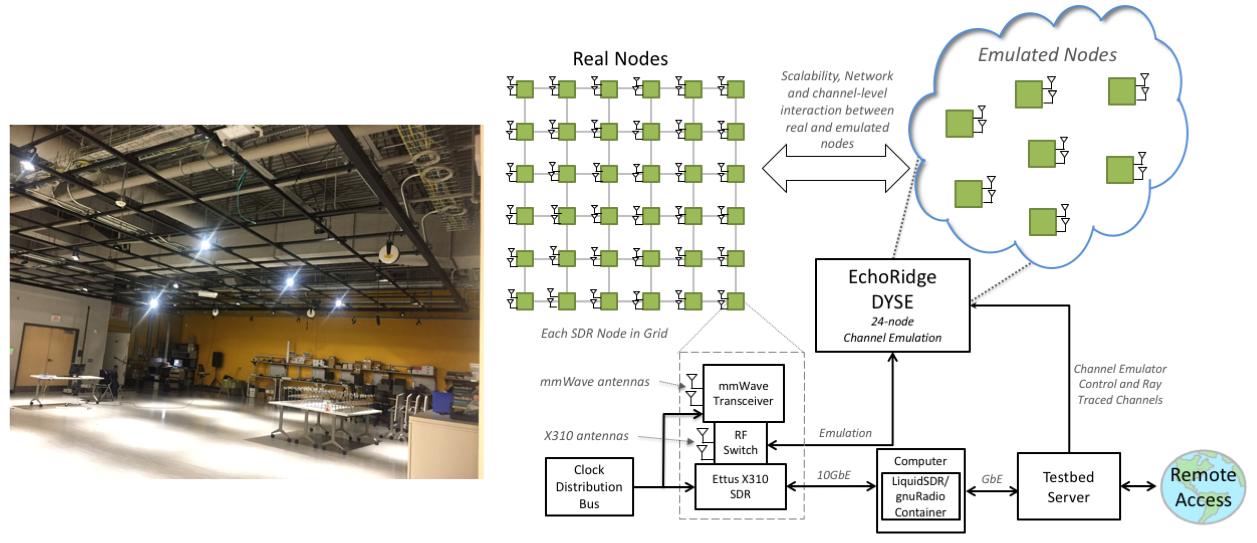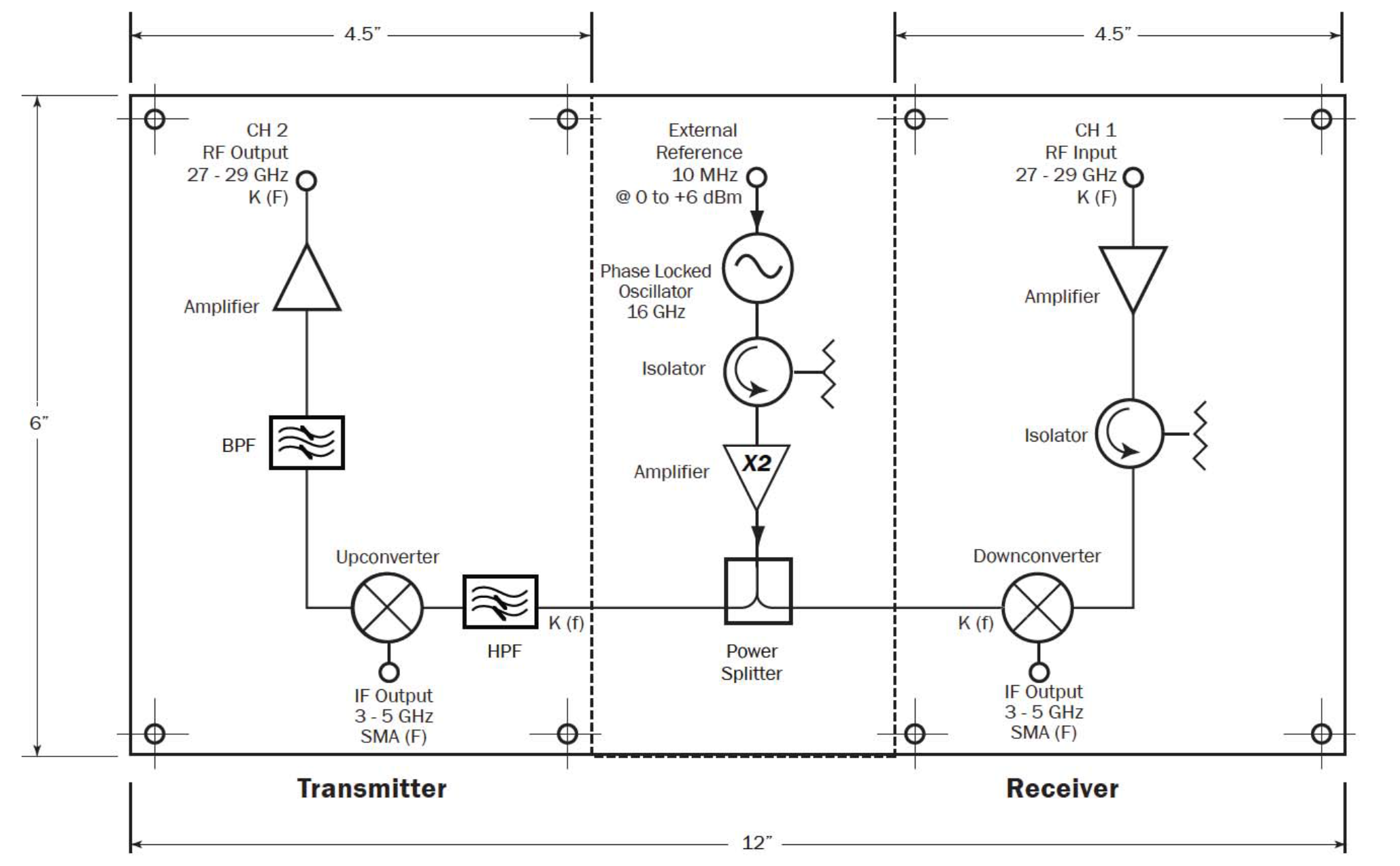Lab Functional Fabrics for the Internet of Things
NSF MRI Award #1828236 MRI: Development of a mmWave Software Defined Radio Network Testbed for Hybrid Measurement and Emulation
Personnel:
PI: Kapil R. Dandekar
Co-PIs: Geoffrey Mainland, Steven Weber, Nagarajan Kandasamy
Post Doctoral Researchers:
Vasil Pano
Graduate Students:
Oday Bshara
Undergraduate Students
Goals
The largely unregulated and unused millimeter wave (mmWave) frequency band is a potential home for new standards and protocols to increase network capacity (especially for a future 5G cellular communication standard). This project builds, deploys, and makes available to the research community a mmWave Software Defined Radio (SDR) network testbed. A pressing need exists for flexible hardware platforms to:
Major Goal #1: Rapidly prototype new mmWave systems that consider not only point to point deployments, but also new multi-link mmWave network architectures;
Major Goal #2: Allow for co-design of antennas, waveforms, and networking algorithms – a requirement given the unique propagation characteristics of mmWave channel; and
Major Goal #3: Allow for hybrid measurement and emulation to allow real and virtual nodes to co-exist, which would enable scalable studies of new mmWave network architectures.

Intellectual merit
The intellectual merit of the project includes:
Flexible, real-time prototyping - The vast majority of SDR platforms are focused on small variations of WiFi, and existing mmWave SDR platforms are focused on point to point prototyping. The proposed mmWave SDR Network Testbed will leverage our experience with antenna, physical layer, and full-radio prototyping (e.g., DARPA SC2) to enable development and testing cross-layer, multi-link mmWave networks. The timing and synchronization capabilities of the mmWave SDR Network Testbed will enable “exotic” mmWave physical layers (e.g., massive MIMO, distributed beamforming) to be tested for the first time in a large-scale network setting.
Repeatable and customizable channels - Many existing wireless testbeds in fixed-grid deployments (e.g., ORBIT) or ad hoc deployment across urban (e.g., RoofNet, CitySense) or campus areas (e.g., emuLab, EWANT, MiNT, MeshTest) do not have customizable and repeatable physical layer propagation channels. The proposed mmWave SDR Network Testbed will make use of a 24 port multi-channel emulator (Echo Ridge DYSE) to create customizable and repeatable channels using industry-standard channel models, mmWave channels imported from ray tracing, and custom channel models derived from the mmWave channel sounding literature. Through the use of switching at both the intermediate frequency and radio frequency, the testbed will also enable OTA testing in both the 10MHz–6 GHz band and mmWave band in an indoor office environment with novel antenna technologies that provide broadband and directional radiation pattern capabilities.
Scalability - While testbed-based measurement campaigns often provide greater realism, they usually also suffer from a lack of scalability (i.e., less than a dozen nodes in any single experiment) given the difficulty and expense in developing and maintaining custom hardware. The mmWave SDR Network Testbed addresses this limitation by providing a software API and hardware network emulation that will allow physical nodes and virtual nodes to co-exist with one another from the perspective of the overlying network as well as the underlying physical layer propagation channels. Drawing upon best practices from emuLab, GENI, ORBIT, our experiences with the DARPA SC2 Colosseum, and integration with the Echo Ridge DYSE codebase, we will provide a software API that can be used by the academic and industrial research community to run large-scale networking experiments combining real and simulated nodes.
Broader impacts
The project has specific broader impacts, demonstrated through the following activities:
Community Testbed for Remote Experimentation - Drawing from best practices from existing wireless network testbeds, we will make the developed testbed available to the academic community. Providing an experimenter interface similar to the DARPA SC2 Colosseum will reduce barriers to adoption.
Significance of the Enabled Research - The proposed testbed will enable a wide variety of research projects of relevance to the industrial and academic community, and across NSF directorates. The research enabled by the testbed will be relevant to the NSF Platforms for Advanced Wireless Research (PAWR) program which has an emphasis on prototyping 5G and mmWave radio networks. Furthermore, the modular mmWave transceiver developed for this project by our partners at National Instruments will subsequently be commercialized for future sale to NI customers.
Undergraduate and Graduate Student Training - Design projects related to research enabled by the proposed testbed will be incorporated in course modules in the Drexel engineering curriculum. Undergraduate and graduate students will benefit from interdisciplinary WlmmWave networking projects to develop the testbed and create the next generation of experimentalists. Students, with special emphasis on women and under-represented minority students, will be recruited to work on project-related activities with the PI through both undergraduate and graduate course modules, as well as through the new Drexel Vertically Integrated Projects (VIP) program.
Activities
The Drexel SDR Grid Testbed is currently being upgraded with a suite of National Instruments (NI) X310 SDRs which will work in tandem with the new mmWave (27–29GHz) transceivers from Spacek Labs. In order to fully utilize the capabilities of the X310 SDRs and the mmWave transceivers, we are building a high-performance server equipped with multiple state-of-the-art DELL PowerEdge R6515s that will go hand-in-hand with the new RF hardware.

Publications
Dandekar, Kapil R. and Begashaw, Simon and Jacovic, Marko and Lackpour, Alex and Rasheed, Ilhaan and Rey, Xaime Rivas and Sahin, Cem and Shaher, Sharif and Mainland, Geoffrey. “Grid Software Defined Radio Network Testbed for Hybrid Measurement and Emulation,” 2019 16th Annual IEEE International Conference on Sensing, Communication, and Networking (SECON) (SECON 2019), 2019.
Liu, Yuqiao and Bshara, Oday and Tekin, Ibrahim and Dandekar, Kapil R.. “A 4 by 10 series 60 GHz microstrip array antenna fed by butler matrix for 5G applications,” 2018 IEEE 19th Wireless and Microwave Technology Conference (WAMICON), 2018.
Liu, Yuqiao and Bshara, Oday and Tekin, Ibrahim and Israel, Christopher and Hoorfar, Ahmad and Taskin, Baris and Dandekar, Kapil R.. “Design and fabrication of two-port three-beam switched beam antenna array for 60?GHz communication,” IET Microwaves, Antennas & Propagation, v.13, 2019.
Bshara, Oday and Liu, Yuqiao and Tekin, Ibrahim and Taskin, Baris and Dandekar, Kapil R.. “mm Wave Antenna Gain Switching to Mitigate Indoor Blockage,” 2018 IEEE International Symposium on Antennas and Propagation & USNC/URSI National Radio Science Meeting, 2018.